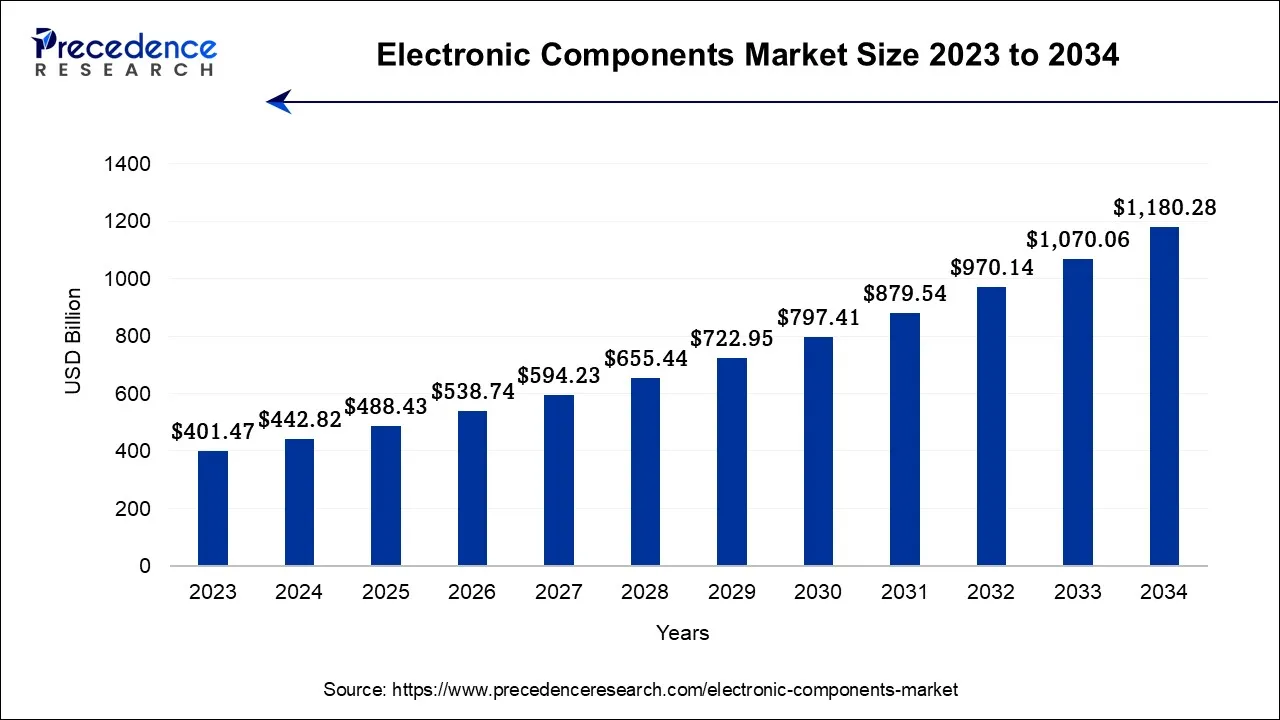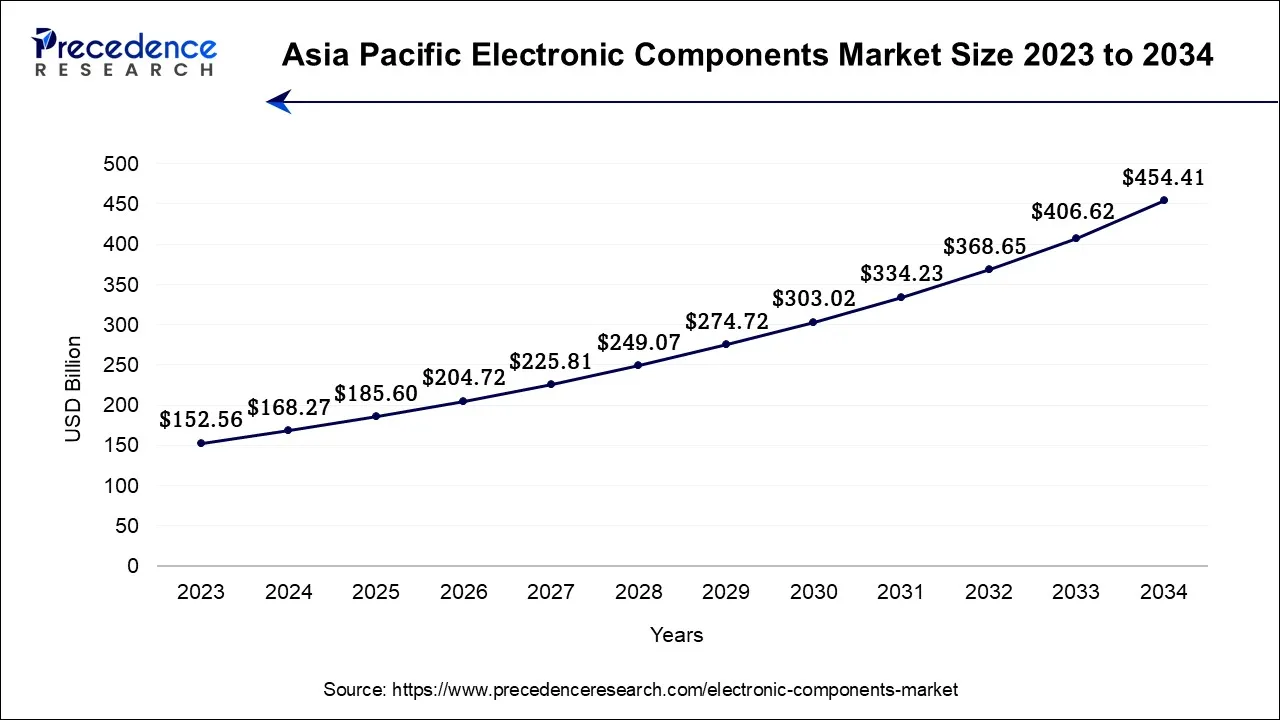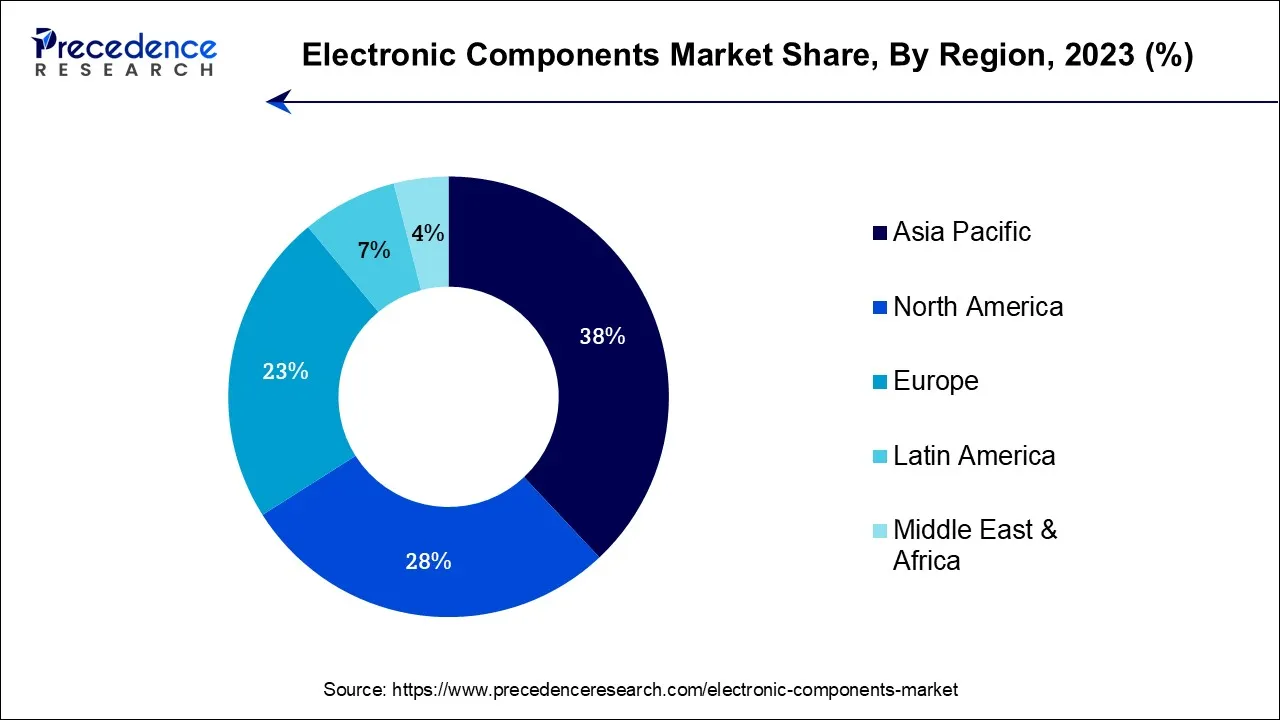January 2025
The global electronic components market size is calculated at USD 442.82 billion in 2024, grew to USD 488.43 billion in 2025, and is predicted to hit around USD 1,180.28 billion by 2034, poised to grow at a CAGR of 10.3% between 2024 and 2034. The Asia Pacific electronic components market size accounted for USD 168.27 billion in 2024 and is anticipated to grow at the fastest CAGR of 10.44% during the forecast year.
The global electronic components market size is expected to be valued at USD 442.82 billion in 2024 and is anticipated to reach around USD 1,180.28 billion by 2034, expanding at a CAGR of 10.3% over the forecast period from 2024 to 2034.

The Asia Pacific electronic components market size is accounted for USD 168.27 billion in 2024 and is projected to be worth around USD 454.41 billion by 2034, poised to grow at a CAGR of 10.44% from 2024 to 2034.

Asia Pacific is expected to dominate the market over the forecast period. This is due to labor being inexpensiveness, raw materials being easily accessible, and production costs being low in this area. Moreover, the market for passive and interconnecting electronic components has been steadily expanding due to the strong demand for consumer electronics made in Asia Pacific, particularly in China and India. The country has seen a sharp increase in demand for computers, as well as other electronic devices like mobile phones, LED displays, and multipurpose processors, due to growing income levels and improving living standards.
Moreover, there is a growing international market for low-cost consumer electronics made in China. The Chinese government has consistently supported research and development (R&D) endeavors and encouraged the establishment of industrial parks in Chinese cities to facilitate the manufacture of electronic components. Additionally, the Indian government is offering several incentives to enterprises that spend $400 million within the projected term. Thus, this is expected to drive the market growth in the region.

North America has a substantial electronic components market, driven by its advanced technological infrastructure and strong presence in industries such as automotive, consumer electronics, aerospace, telecommunications, and healthcare. The demand for smartphones, tablets, laptops, wearables, and other consumer electronic devices drives the need for various electronic components like microprocessors, sensors, displays, and memory chips. Moreover, Leading semiconductor and electronic component manufacturers, including Intel, Texas Instruments, Qualcomm, Broadcom, and NVIDIA, have a significant presence in North America. Many startups and smaller companies are also active in designing and producing electronic components. Therefore, the aforementioned statements are expected to propel the market growth during the forecast period.
Electronic components are fundamental elements that make up electronic circuits and devices, playing a crucial role in modern technology. They are the building blocks that enable the manipulation and control of electrical signals, allowing devices to perform a wide range of functions. From simple switches to complex microprocessors, electronic components form the foundation of everything from everyday consumer electronics to advanced industrial systems. The world of electronics revolves around the concept of using various components to create circuits that can process, transmit, and store information in the form of electrical signals.
These signals can represent data, perform calculations, generate sounds, display images, and many other applications. Electronic components can broadly be classified into two main categories which are passive and active components. Passive components do not require an external power source to perform their basic functions. They interact with electrical signals but do not amplify or generate them. Besides, the active components require an external power source to perform their functions. They can amplify, switch or modulate electrical signals.
By 2025, the GSMA predicts that 5G networks will reach 1.2 billion connections or one-third of the world's population. The rising integration of 5G network services across the globe is observed to boost the demand for electronic components. The market growth is being driven by several factors such as increasing demand for consumer electronics, the rollout of 5G networks and the growth of high-speed data communication, advancements in IoT, and increasing industrial automation.
| Report Coverage | Details |
| Market Size in 2024 | USD 442.82 Billion |
| Market Size by 2034 | USD 1,180.28 Billion |
| Growth Rate from 2024 to 2034 | CAGR of 10.3% |
| Largest Market | Asia Pacific |
| Base Year | 2023 |
| Forecast Period | 2024 to 2034 |
| Segments Covered | By Type and By Application |
| Regions Covered | North America, Europe, Asia-Pacific, Latin America, and Middle East & Africa |
Growing demand for robots across the industry
Product manufacturers are implementing robots to automate some of the repetitive procedures due to rising demand across economies. An estimate of the penetration of industrial robots is provided by the Robotic Industries Association, which states that more than 250,000 industrial robots have been installed in the United States alone. Additionally, due to the growing use of smart manufacturing systems, in which these robots play a crucial role, the industrial robotics market has been seeing enormous demand over the past ten years. Every section of the robot receives signals and power to engage its functions through passive and interconnecting electronic components. Therefore, the aforementioned facts drive the market growth during the forecast period.
Decrease in the profit margins of manufacturers
Hardware prices are decreasing as a result of advances in device technology, but they are still rising as a result of the ongoing demand for increasingly complex and specialized products. The cost of passive and active components is being directly impacted by product counterfeiting. In addition, the prices of interconnects and passive components have decreased as a result of the fierce rivalry between players from different locations. The price of developing new products or goods driven by cutting-edge technology is negatively impacted by this. Therefore, this is expected to hamper the market growth during the forecast period.
Increasing adoption in the automotive sector
The transition to lane-keeping and adaptive cruise control as Advanced Driver Assistance Systems (ADAS) and higher levels of vehicle autonomy are increasing demand for interconnects and passive components. More passives are required by infotainment systems as well. The need for passive components will also rise as more vehicles move to hybrid and eventually entirely electronic powertrains. As well as advanced ECUs, regenerative braking, and battery-charging techniques, hybrid cars require sophisticated ECUs to regulate the changeover between electric and internal combustion engine (ICE) driving.
The difficulty of operating a hybrid powertrain is replaced in fully electric cars by the struggle to get a predictable range, quick charging, and adequate performance out of still-evolving battery technology. To handle the flow of enormous amounts of electrical energy, all of this necessitates sophisticated sensing, reliable communications, and substantial usage of power electronics devices and their accompanying circuitry. Thus, this is expected to offer a potential opportunity for market growth during the forecast period.
Based on the type, the global electronic components market is segmented into active, passive and electro-mechanic. The active segment is expected to capture the largest market share over the forecast period. The segment growth is attributed to the increasing application of active components in various industries including consumer electronics, automotive, telecommunication, industrial automation and others. Moreover, the growing product launches are expected to propel the market growth. For instance, in January 2023, Renesas unveiled a new intelligent power device (IPD) for automobiles that manage power distribution in cars flexibly and safely to satisfy the demands of the next E/E (electrical/electronic) designs. Thus, this is expected to drive market growth during the forecast period.
Based on the application, the global electronic components market is segmented into automotive, communication, computing, industrial and others. The automotive segment is expected to grow at the highest CAGR over the forecast period. To attract customers, automakers all over the world concentrate on incorporating different electronics and technologies.
The market for automobile electrical components has been significantly impacted by the rising demand for premium and ultra-luxury automobiles. The usage of electronic components in automobiles has expanded recently due to the rising reliance of these cars on safety systems and other electronic components. It is common practice to employ electronic components to improve the performance and efficiency of powertrain systems. These parts provide communication between the powertrain systems of a car and allow sensor signals to be exchanged, all while controlling the systems' functions. Sensors for throttle position, transmission fluid temperature, and turbine speed are all utilized in powertrain systems.
On the other hand, the communication segment is expected to capture a significant market share over the forecast period. The use of electronic components in the telecommunications sector is anticipated to increase throughout the projected period due to technological advances such as the transition from 4G to Voice over Long-Term Evolution (LTE/4G) and 5G. Network equipment, remote controllers, mobile phones, landlines, set-top boxes, and base stations are a few examples of telecommunication applications. Moreover, the telecom industry is using more and more electronic components as a result of the smartphone industry's notable expansion and the mobile handset market's subsequent rise. Thus, these factors are anticipated to drive the market over the forecast period.
Segments Covered in the Report
By Type
By Application
By Geography
For inquiries regarding discounts, bulk purchases, or customization requests, please contact us at sales@precedenceresearch.com
No cookie-cutter, only authentic analysis – take the 1st step to become a Precedence Research client
January 2025
January 2025
December 2024
January 2025